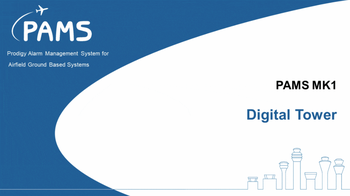Digital Tower
ATC/ATE ground based systems alarm status management for Digital Towers.

Overview
PAMS replaces the traditional alarm panels with a modern PC based solution that provides a number of benefits:
• Information from a range of sources (for example, CNS (Communications, Navigation and Surveillance) devices) is integrated into one location, making it easy to get an overview of the current status of ATC
• Presenting the equipment statuses in an easy to understand way, and in a variety of locations improves its visualisation and usability
• Recording alarm conditions into a database, with timestamps, details of event acknowledgements etc. allows the information to be reviewed and analysed for patterns or to refine the resulting actions
Status Updates
PAMS has the capability of receiving updates from a wide range of third party airfield equipment, such as:
• VCS / EVCS
• Recorders
• ILS
• DME
• NDB
• IRVR
• SAMOS
• Radios (UHF / VHF)
• Air Compressors
• Desk and Equipment UPS
• NTP Time Server
Interfacing can be through a variety of means including:
• Simple status updates with switch to earth (or volt free contacts), either locally in the PAMS Site System Server equipment rack or in remote locations on the airfield or surrounding area
• LAN based SNMP communications interfaces, retrieving not only status information but also settings such as radio frequencies (VHF / UHF) or runway selection
• Links to an NTP time server to synchronise the PAMS equipment clock with the site
• Communications with a wide variety of legacy equipment through serial and LAN interfaces using, for example, OPC or Modbus protocols
Improved Visualisation
The Alarm Status displays incorporate a number of features to ensure the information is clear and easy to understand.
The current statuses can then be presented to both ATE through a local display (often duplicated with a KVM extender to be located in the Engineering offices), and be broadcast over the site LAN, to PAMS Workstations used by ATCOs in the controller positions in VCR, ACR etc.
Unlike a fixed, traditional alarm panel with buttons and lamps, colour coding can be used on the alarm buttons to indicate the current status:
• Green is fully operational, whereas red indicates an alarm condition
• Flashing red highlights an alarm condition that hasn’t been acknowledged, whereas steady red means that it has been
• Blue is used for equipment that is undergoing preventative maintenance
• Yellow is used to indicate a communications link failure, and grey for inputs that are not in service
Each alarm button includes a description that can be easily changed through a form (assuming the user has appropriate privileges).
Input signals from multiple items of equipment can be combined into a group. For example, if the Primary radar is from one suppler and the secondary radar from another, they can still be combined to highlight when the radar as a whole is fully operational, in a degraded state, or in a full alarm condition.
Acknowledging Alarm Conditions
All PAMS HMIs make use of touchscreen technology. This makes it easy to acknowledge an alarm condition; it is as simple as pressing a button.
Alarm conditions can also be re-generated by setting a nag period. This ensures that an issue is not simply acknowledged and ignored, as it will repeatedly trigger itself until the input has been reset.
Reverting alarm conditions must also be acknowledged, to make sure that the users are aware that the issue has been resolved.
From time to time, some equipment may conduct a self-diagnostic test that triggers an alarm condition. Where required these can be masked to prevent ATC from being given false information. A number of approaches are available but typically this is achieved by setting a configurable Hold Off time for the input.
Data Analysis
Every alarm event results in a recording being made into PAMS’ SQL or MS Access database. These are timestamped down to a millisecond according to when the condition was first identified, acknowledged etc.
On all PAMS HMIs an Alarm Banner is available at the top of the screen. This provides access into not only the current alarm and event conditions, but also into the historic data. PAMS automatically provides information on the number of times a particular alarm condition has been triggered, how long it was in an alarm state for, how long it look before it was acknowledged etc.
Augmenting alarm events with comments can add to the depth of information available when analysing the data. Optionally, PAMS can be configured to require a comment to be entered when acknowledging an alarm condition. If needs be, this can also be deferred so that the cause can be investigated before an entry is made.
PAMS also includes a number of report formats, so that periodic reviews can be completed using any time frame. Typically these are generated as pdf files and can be automatically triggered to be generated, for example, at the start of each week. Where required they can also be emailed to relevant ATE personnel, as attachments.
Escalation Functionality
Alarm groupings allow for degraded states to be identified by PAMS so that they can be managed out by ATC, without necessarily requiring an immediate ATE intervention.
PAMS can also provide access into online SOPs so that the appropriate method for dealing with an issue can be linked to the alarm button on a display. Simply clicking on the associated Help icon will pop-up the relevant Standard Operating Procedure.
In some cases, however, an escalation / notification process needs to be in place to flag more critical issues, more quickly. This can be through:
• SMS text messages to appropriate (on-shift) ATE personnel
• Email alarm notifications to on-shift staff
• Intercom (Tannoy) announcements using pre-recorded or synthesised messages
• Beacons and klaxon sounders


